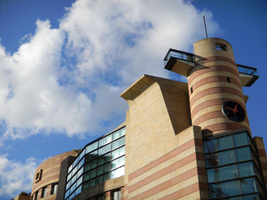Nikon S1000pj at a glance
- 12.1-million-pixel CCD sensor
- 5x optical zoom
- (28-140mm equivalent)
- 2.7in LCD screen
- ISO 80-1600 (ISO 6400 at 3MP)
- Street price around £350
Nikon S1000pj – Introduction
Printing, I suppose, is the most obvious option for those looking to build some form of output device into a digital camera, but only because we got used to the idea of Polaroid cameras over the past 60 years. In fact, Polaroid is the only company that has attempted something similar in a digital camera with its PoGo model.
However, on face value, incorporating a printing device in a camera seems an unlikely idea, as the standard camera has none of the components required other than power. Also, unless you are happy with tiny prints, the media is bulky, which makes for an unwieldy camera.
One might think, then, that a camera that projects its own images is a much more logical progression, as all that would be needed is a light to push the captured images back the way they came, through the lens.
Nikon’s S1000pj is the first such digital camera to incorporate its own projector, and while the complications that must surely have gone on inside to make it work are well hidden beneath the silvered, boxy surface, one wonders why no one has thought of it before.
You might be forgiven for forgetting that the primary use of the S1000pj is as a 12.1-million-pixel compact camera. It features a 5x Vibration Reduction zoom lens that covers angles we’d expect of a 28-140mm lens on a 35mm camera, and displays recorded images and menus on a 2.7in LCD.
In addition to fully automatic operation, the camera offers 17 subject- or task-based shooting modes, including a panorama assistant, and the usual portrait, beach, macro and fireworks type settings.
Other than some selection options for resolution, exposure compensation and flash controls, there are few choices to be made. This is, it seems, a camera aimed squarely at the point-and-shoot photographer. The picture quality is fairly ordinary, but adequate for the level of potential user dictated by the detail of camera-control.
I found the lack of white balance control frustrating, but the camera seemed to cope well without me. For people who only print to sizes below 10x8in, this camera is likely to be absolutely enough.
The projector

Unlikely to light up a room in your local village hall, the projector built into the S1000pj has a power rating of 10 lumens, a life of 1 hour on the camera’s battery and a range (throw) of 26cm to 2m. At that furthest distance the projector can produce a picture of about 40in across the diagonal.
In a darkened domestic lounge or dining room, with a suitably white wall or ceiling, the picture is surprisingly clear and bright, but getting the picture square on is not so easy. The colours are really very good, as is the sharpness of the manually focused image, though the slight fringing and VGA resolution take the gloss off a little.
This is a ‘for fun’ device that makes an impression even in indoor daylight and it isn’t really designed to be a sure way of proofing one’s images – although the experience of seeing your pictures enlarged on a wall is a great help in determining their worth.
An ability to project PowerPoint presentations and so on would have made this a best-selling business tool as well as a fun party camera. And an auto image rotate feature would make tripod-mounted scrolling less frustrating, though of course upright images would become smaller.
Our verdict
It is very difficult to get around the fact that the projector element of this camera is breathtakingly spectacular, but once the initial ‘Wow!’ has died down it becomes clear that the projector is of less than perfect quality. Even so, simply as a means to show your pictures big on the wall, right after taking them, it is amazing.
There will be plenty of people, I know, who will declare they are not interested in having this kind of technology in a camera, but I do hope Nikon sticks with it and brings it into more advanced products. It’s true that you can buy a small personal projector and a digital camera separately for about the same price, but there’s not nearly the same amount of fun in that.
In time, it will be possible to use a higher resolution and more powerful projector, and one that has automatic shape and colour corrections, but for now this is a great start. I wonder what we will see it in next: DSLRs, perhaps?


Above right: I had to remove some green and cyan to get a nice colour balance for this early morning scene. Above left: At small print sizes image quality is fine, but when enlarged the soft, smeared edge detail became noticeable








